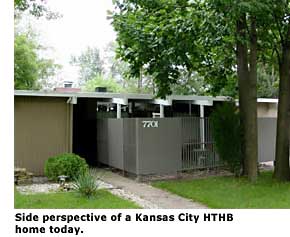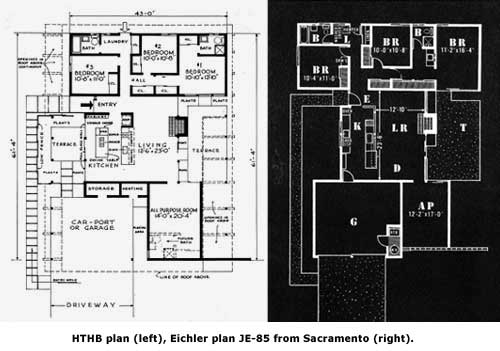The House that 'Home' Built - Page 2
A version of the JE-85 appeared in 'House and Home' in July 1955, and seemed to be the immediate predecessor to the 'House That Home Built' model. Photographer Ernie Braun's photos for the article were dated April 1955, taken less than a month after Eichler's appearance on the NBC program. Jones and Emmons had designed more than 200 plans for Eichler by 1955, according to House and Home at the time, and the 'House That Home Built' seemed to be the pinnacle of this particular plan type. Soon Eichler's focus would shift to plans around courtyards and atriums.
Unlike earlier Eichlers, the post-and-beam frame and fascia of the 'House That Home Built' extended past the roof eaves to form a trellis-like-overhead structure on the side terraces. Two things Jones thought unusual were the location of the laundry between bedrooms, and a built-in dining table with two built-in burners and an oven at the end. Jones had recently designed a similar prototype kitchen for Frigidaire. A table cook top was also included in Jones' own steel house built for his family in 1954 in Southern California and the X-100 steel prototype of the San Mateo Highlands that he designed for Eichler a year later.
The most notable refinement to the new plan was a sliding-glass door between the kitchen and terrace. "This blew the whole center of the house open," says Scott Lane, a Kansas City real estate broker and a former owner of two Drummond homes. Other changes included the substitution of a carport for a garage and revised bathroom locations.

Eichler and Drummond were masters of merchandising. It is no coincidence that the kitchen, baths, and laundry were the focus of changes to the plan. This reflects the power women were gaining over such major decisions as buying a house. Not relying solely on NBC's Home to reach would-be buyers, Drummond had a local cooking show broadcast from the kitchen of his model home. The show promoted appliances that could be purchased with the home. "There was a nice little profit to be made from the sale of these appliances with the house," Drummond says.
Some of the builders who took on the 'House That Home Built' challenge may have been nervous about the home's modern touches, but not Drummond. Unlike most of the builders, who constructed only one home, Drummond was soon-building several. Drummond was unsure about one aspect of the house—the master bedroom's sliding-glass door. But he was overruled by his wife and partner, Frances (who was responsible for-her husband's career-making decision to hire a real architect to design his homes). "Francie thought it was a good idea, so we kept it," says Drummond. "She thought it would appeal to the women."
Cleveland builder Peter Krutschnitt modified the plan, probably to deal with harsh winters. As seen in a 1955 advertisement for Fenestra Windows, the house was rotated so its side entry now faced the street, something Drummond did as well. The carport was replaced by a garage, and the roof overhangs were extended to provide protection for rafter ends.
By late spring the publicity for the homes was beginning to peak. The June 1 episode of Home featured a segment showing Thomas Church, one of the founders of modern landscape architecture, preparing designs for Eichler. And across the country, builders were hustling. "My father had workmen working day and night the last two weeks of the project," says Henry Schwier, Jr., the son of New Jersey builder Henry Schwier.
On June 3, the day before the homes' public opening, the entire show was devoted to the 'House That Home Built,' beginning with a race among movers in San Francisco, Chicago, Kansas City, and Denver to outfit the homes with model furnishings. Afterwards, each builder was interviewed.
Not every builder, however, crossed the finish line on June 4. Some builders blamed the delays on a late spring. Others had trouble getting FHA approval for loans. Eichler and Drummond finished their houses on time along with at least seven other participants. At least 11 builders were given a second deadline, September 10, during National Home Week. All of the latecomers who finished for this deadline were from northern states.

Most of the builders did well thanks to the program. "Eleven sales consummated, $242,000 volume," Drummond telegraphed Home in late June. "Thirty sales in process of being signed, at $720,000. Three weeks after Home promotion, sales response becoming stronger daily. Public thinks house is wonderful. It is affecting the desire to buy... Combined promotional effort is now snowballing. Market appears unlimited here. Will appreciate the opportunity to cooperate with Home in any way."




